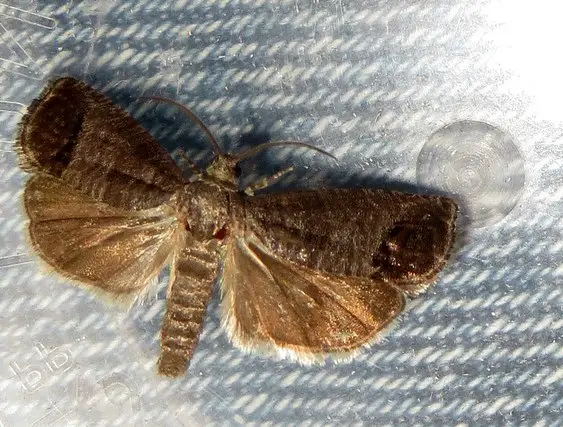To control and prevent the attack of codling moth on fruits and trees it is necessary to develop an understanding of the Codling moth. What are the life stages of Codling moth? How does it cause infestation or plant damage? How can Codling moth be managed in different stages?
The article gives a complete layout of the above questions and provides a complete guide to control codling moth by using different methods.

What Is The Codling Moth?
Codling moth (Cydia pomonella), is the most destructive insect pest of pome-bearing fruits. This moth is one of the wide-spread pests of orchard plants, which commonly attacks apples, apricot, pear (stone fruits), walnuts and quinces. It creates a small hole in the fruit at the blossom end, in which the pinkish-white moth with brown heads eat the fruit flesh directly to the core and leaves its sawdust-like fecal material in the hole known as frass. The feeding of larvae in fruit can cause premature fruit drop. The infected fruit is unhealthy to eat and it also immensely decreases the fruit market value and crop yield
Life Stages Of The Codling Moth
In winter, fully matured larvae pass through the cocoon stage and lives under loose tree bark, debris or orchard litter. Pupae formation takes place in mid-spring and a grayish brown moth develops in the late spring. The mature codling moth lay eggs on the tree leaves, fruits and twigs. The larvae depend on the tree leaves for nourishment before infesting fruit. After 3 to 5 weeks the moth develops and move down the trunk to turn into pupae. The codling moth comprised of three prominent life stages, and take 1 year to complete
Type of Plant Damage From Codling Moths
The Codling moth severely damages the fruit market value as its larvae penetrate inside fruit and creates a hole. It feeds on the fruit and defecates a crumbly, reddish brown waste. Its larvae can damage 20 – 90% of the fruit depending on the location and variety of the fruit. The fruit damage may be affected by the length of time fruit needs to mature, the late maturing varieties suffer more than others. In walnut trees, the codling moth larvae infest the kernels of walnut, and the nuts of the tree will fall off earlier after infestation.
Methods to Control Codling Moth
It’s easy to manage Codling moth attack at an early stage, but pest management becomes difficult after a season or two. There are a variety of non-chemical methods to control Codling moth in early developmental stages. When the pest population is moderate to high, the chemical method is best utilized to manage the moth population.
Below is a list of the common methods used to control and manage codling moths:
- Nematodes Application: Nematode (Steinernema feltiae) is a codling moth larvae predator, show striking results by feeding on larvae under the soft-barked tree of orchards.
- Synthetic Pheromone Trap: Synthetic pheromone trap is a sex-attractant of adult male Codling moth. The chemical helps to trap the moth and mess with their mating. The process helps to decide the best time period for insecticide spray or predator wasp can be used to fight against pest. Addition of 1% of oil will make its application more effective.
- Plant-based insecticides: Plant-based organic pesticides are really useful and non-toxic to manage Codling moth. Spray this insecticide with 1 – 2 weeks of interval when 75% of the petals had fallen.
- Spinosad: The eco-friendly, biologically synthesized spinosad is chemical pesticide made from Saccharopolyspora spinosa bacterium. The chemical is sprayed at the start of egg hatch and after 10-14 days. Spinosad must not be sprayed more than 6 times per season.
- Granulosis virus: The CYD-X granulosis virus affects the moth larvae and damage the Caterpillar digestive tract, leads to its death in 3 – 7 days.
- Carbaryl: Carbaryl (Sevin) impressively manages codling moth and a wide range of pests, it remains efficient for 14 to 21 days. For a heavily infested tree, spraying it once is enough. Do not apply it before three days of fruit harvest and 14 days of walnut harvest.
- Fruit Thinning: Fruit thinning can be helpful in the removal of moth and reducing the point of contact of Codling moth.